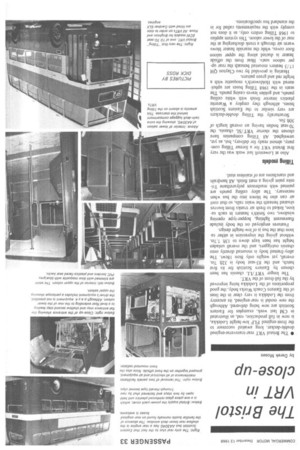The Bristol VRT in close-up
Page 35

If you've noticed an error in this article please click here to report it so we can fix it.
by Derek Moses • The Bristol VRT rear-transverse-engined double-decker, long awaited successor to the front-engined FLF low-height Lodekka, is now in full production, Pmd, as illustrated in CM last week, examples for Eastern Scottish are now being delivered. Although the new model is rear-engined, its ancestry from the Lodekka is very clear in the lines of the Eastern Coach Works body, the good proportions of the Lodekka being improved by the full-front of the VRT.
The longer VRT /LL chassis has been chosen by Eastern Scottish for its first batch, and the 83-seat body is 32ft 7in. overall, yet weighs only 8tort 18cwt. The alloy-framed body is mounted directly onto chassis outriggers, and the overall unladen height has been kept down to 1311 7.7in. without giving the impression in either saloon that the bus is of low-height design.
Features employed on the body include fluorescent lighting, hopper-type opening windows, two Smith's heaters in each saloon, linked to fresh air trunks from louvres situated beneath the waist rails, so that cool air can also be blown into the bus when necessary. The alloy ceiling panels are painted with mushroom polyurethane Trmite paint giving a matt finish. All handrails and stanchions are of stainless steel.
Tilling models
Also at Lowestoft last week was the very first Bristol VRT for a former Tilling company, almost ready for delivery, but, as yet, • unweighed. All Tilling companies have chosen the shorter VRT /SL chassis, the 70-seat bodies having an overall length of 30ft 3in.
Structurally the Tilling double-deckers are very similar to the Eastern Scottish buses, although they employ a Warerite plastics interior finish with white ceiling panels, and golden leaves casing panels. The seats in the 1968 Tilling buses are upholstered with Holdsworth's moquette with a bright red and green pattern.
Heating is provided by two Clayton QH 17/3 heaters mounted beneath the rear upper saloon seats. Heat from the offside heater is ducted along the upper saloon floor coves, while the nearside heater blows warm air through a trunk discharging at the rear of the lower saloon. This system applies to 1968 Tilling orders only, as it does not comply with the requirements called for in the standard bus specifications.
PASSENGER 33
Right: The only real clue to the fact that Eastern Scottish bus AA304G has a rear engine is the shallow rear lower deck window. The absence of the familiar bustle normally found on rear-engined buses is welcome Below: Bristol supply the power-pack cover, which is a one-piece glass reinforced plastics unit held open by two stays and fastened shut by two Triumph Herald type bonnet clips Below right: The'removal of two panels facilitates maintenance of all electrical and air equipment, grouped together on the front offside. Note also the front-mounted radiator.
Below right: Close-up of the entrance showing the flat entrance step and shallow second step leading to a level floor extending to the rear of the lower saloon. Although p.a.ye. equipment is not provided, the driver's equipment includes a periscope showing the upper saloon.
Below left: Interior of the upper saloon. The seats are trimmed with blue moquette with blue/grey PVC borders and plastics-faced seat backs












































































































